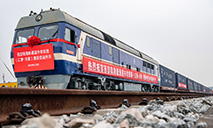Action taken to ensure foreign trade growth
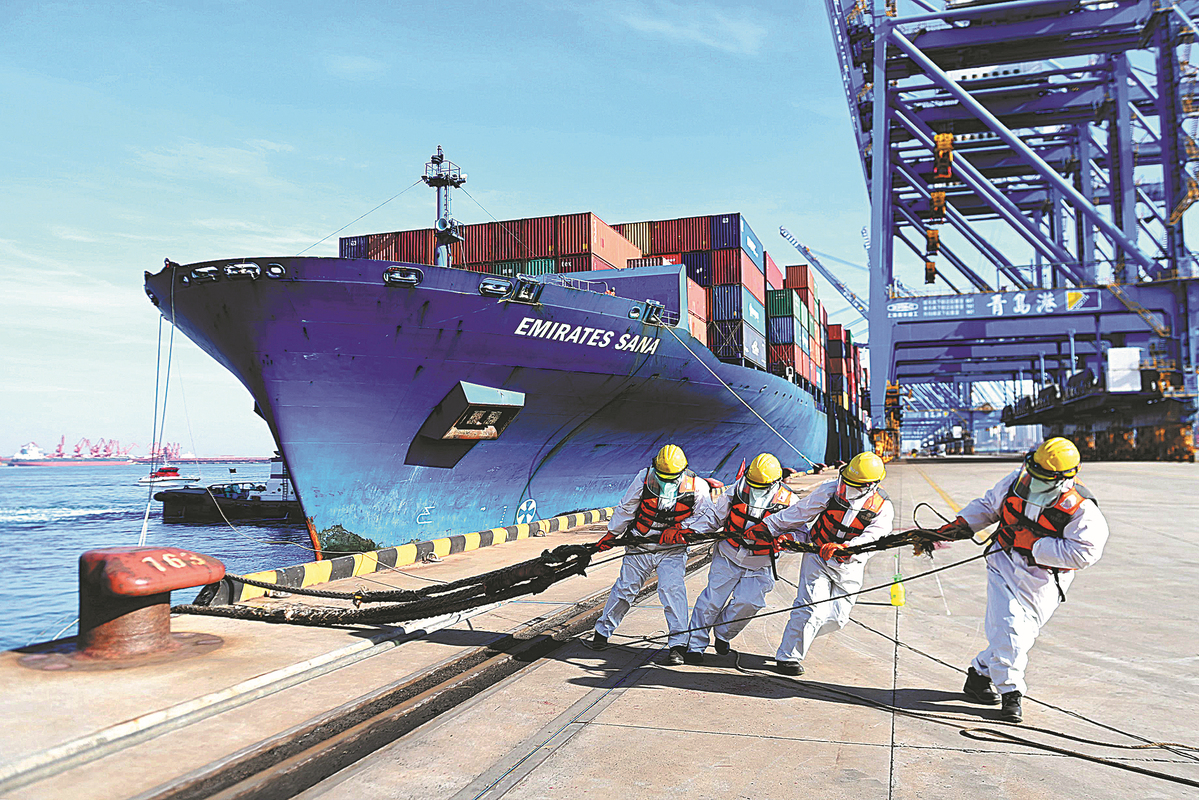
Workers help moor a freighter in Qingdao, Shandong province. [Photo by Yu Fangping/For China Daily]
Hanwei Electronics Group Corp, China's largest manufacturer of gas sensors and instruments, is highly optimistic about its overseas growth prospects this year.
The company, also a leading sensor-based internet of things solution supplier, aims to boost its overseas revenue and profits by more than 50 percent year-on-year by venturing deeper into developed markets such as the European Union and emerging ones, including Southeast Asian countries.
Its confidence is firmly supported by research and development efforts, which have resulted in breakthroughs in core technologies that have boosted product quality and sharply reduced production costs.
Li Zhigang, president of the company, which is based in Zhengzhou, Henan province, said, "We expect to have a significant pickup in sales and profits in overseas markets.
"We've seen a rebound in overseas demand as more countries resume production. Our products also have become more competitive in world markets after receiving highly recognized global industrial and market certification thanks to our progress with innovations."
Founded in 1998, the company is an experienced exporter of gas sensors and instruments. Its overseas sales jumped by more than 30 percent on a yearly basis last year, despite a decline in profits due mainly to a rising renminbi exchange rate, Li said.
The company is one of numerous enterprises involved in foreign trade that are stepping up efforts to seek new growth points. Such endeavors include strengthening product research and development to boost competitiveness and also adopting new foreign trade formats and a more market-oriented approach to innovate marketing and sales practices, such as using cross-border e-commerce and overseas warehouses.
These efforts are being made by enterprises as Chinese authorities roll out adjustments to macroeconomic policy measures. Together with more supportive administrative services, these adjustments are expected to stabilize market entities and cushion economic growth, as the Chinese economy faces the pressures of demand contraction, supply shocks and weakening expectations.
Analysts said the efforts at enterprise level, combined with the effects of government policy measures, will be rewarded with continued expansion and improvements in the structure and quality of China's foreign trade. They will also make a greater contribution to stabilizing global industrial and supply chains and world economic recovery.
China's imports and exports totaled 6.2 trillion yuan ($980 billion) in the first two months of this year, up by 13.3 percent from a year ago, the General Administration of Customs said on Monday.
Exports during this period rose by 13.6 percent year-on-year to 3.47 trillion yuan, while imports reached 2.73 trillion yuan, growing by 12.9 percent on a yearly basis.
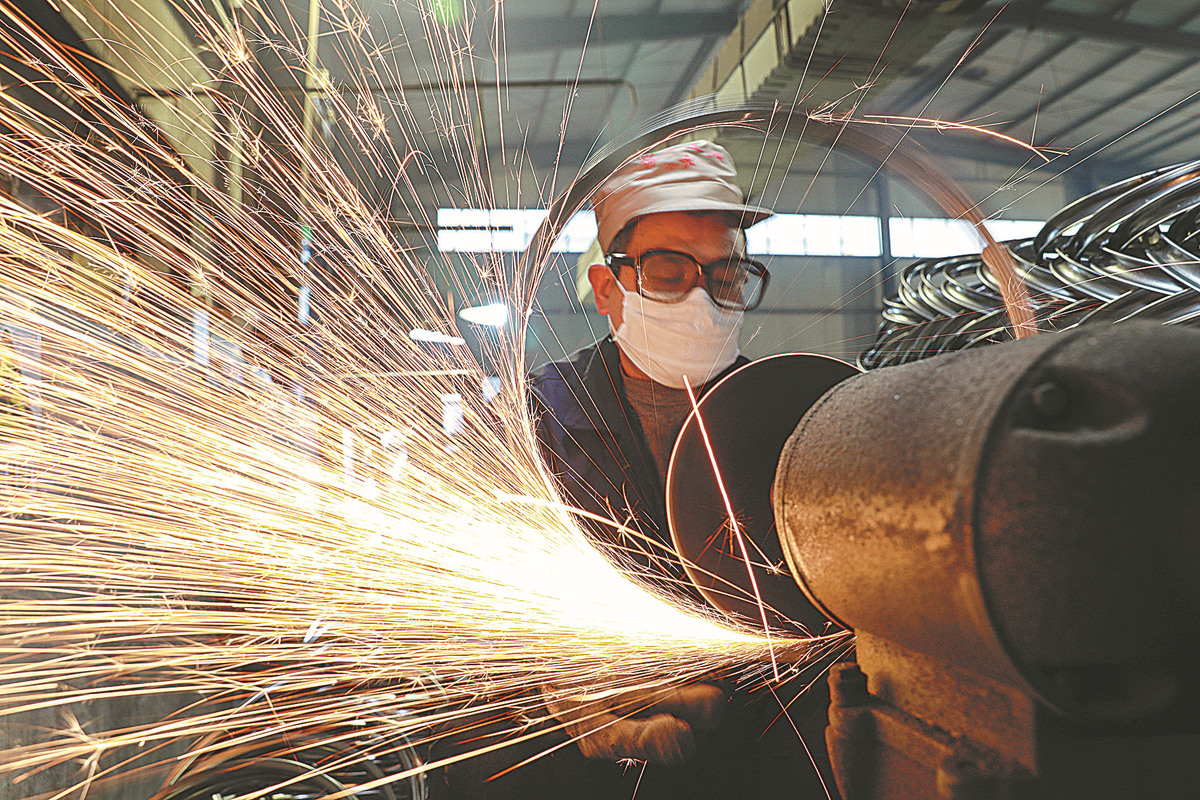
A worker polishes bicycle tire rims at a factory for exports in Hangzhou, Zhejiang province.[Photo by Hu Jianhuan/For China Daily]
Joint result
Li Kuiwen, director-general of the GAC's statistics and analysis department, said those figures showed a stable performance by the nation's foreign trade at the beginning of this year, despite increasingly complex and uncertain external conditions.
This achievement was mainly due to the strong resilience of the Chinese economy, which has long-term healthy fundamentals, as well as the effects of policy measures targeting stable growth, he said.
According to Zhang Jianping, head of the Center for Regional Economic Cooperation at the Chinese Academy of International Trade and Economic Cooperation, or CAITEC, the urgent challenges facing foreign trade this year include a slowdown in global economic recovery due to uncertainties over the pandemic, which is likely to dampen overseas demand for Chinese goods and services.
Persistently high prices for raw materials and transportation will also exert huge pressure on Chinese companies trading overseas, Zhang said, adding that the high comparison base last year also makes it more difficult for the sector to achieve a high level of annual growth.

Household battery storage inverters, mainly for export, are produced at a factory in Hangzhou.[Photo by Xu Junyong/For China Daily]
"The better-than-expected performance last year was mainly due to a series of policy measures stabilizing foreign trade growth, and strict and effective COVID-19 control and prevention methods that enabled China to fully play the role of the largest global manufacturing powerhouse," he said.
"This year, upbeat growth, enhanced quality and improved structure in foreign trade are still to be expected in context of the nation's integrated and large-scale industrial chains and high-level opening-up, especially as China has been rolling out supportive measures to add resilience to the foreign trade sector," Zhang said.
He predicted that the nation will sustain an overall trade surplus while narrowing the trade deficit in services. Zhang also stressed that Chinese enterprises, especially private ones with advanced technologies and independent brands, have become an exceptionally strong force in foreign trade, accounting for about half the nation's exports.
Yin Jinshan, general manager of Hubei Kingshan Lighting Electrico, which is based in Wuhan, Hubei province, is cautiously optimistic about the company's growth prospects this year.
A manufacturer and exporter of home appliances such as rechargeable fans, emergency lamps and desk lamps, along with electric bug killers, the company's products sell well in the Middle East, South Africa and Southeast Asia.
Last year, its overseas sales rose by 20 percent year-on-year, although profit growth fell by more than 10 percentage points, mainly due to surging prices for raw materials and high maritime transportation charges, as well as fluctuations in the renminbi exchange rate.
Yin said, "This year seems to be harder for us compared with 2021, but as long as we survive, there will be huge growth potential for us when the negative impacts of the pandemic gradually fade away, probably next year.
"The government has issued many new policies and provided us with a lot of support, but ultimately we must rely on ourselves rather than others to solve problems, and there is ample room for us to reduce costs and improve efficiency."
The company's intensified new product research and development efforts have resulted in many new offerings that are highly popular with clients. Thanks to its newly established e-commerce team, revenue generated through online channels has compensated for declining orders from traditional offline clients due to the pandemic, Yin said.
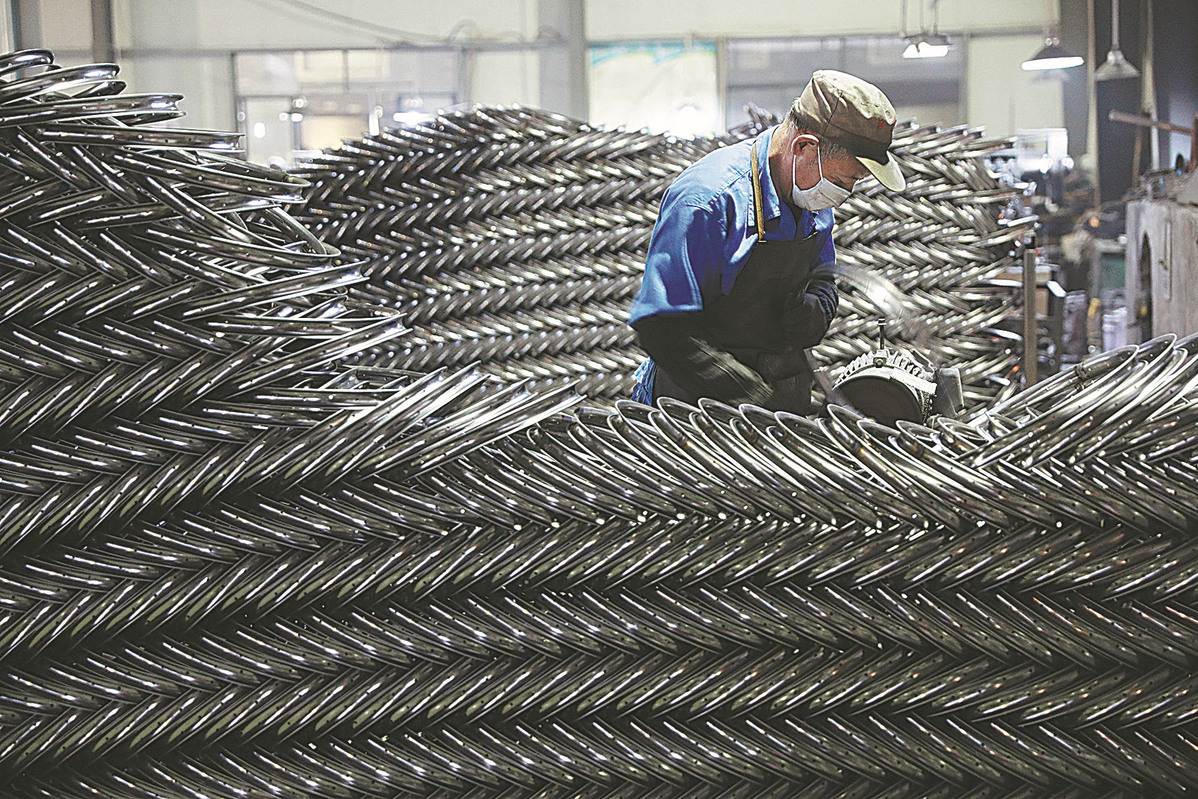
Bicycle tire rims are checked at the Hangzhou factory. [Photo by Hu Jianhuan/For China Daily]
Growth potential
To address urgent and long-term issues impacting the healthy growth of foreign trade, China has released guidelines focusing on cross-cyclical adjustments to help companies secure industrial and supply chains, guarantee foreign trade orders, stabilize expectations, and further unleash the growth potential of exports and imports.
The guidelines, unveiled by the General Office of the State Council in January, detail 15 measures. They include strengthening fiscal and financial policy support, encouraging development of new business formats such as cross-border e-commerce and overseas warehouses, and easing international logistics pressure on businesses.
The measures also include stabilizing development of processing trade, cultivating businesses with strong competitiveness in global export and import markets, and enhancing trade liberalization and facilitation.Zhao Ping, vice-dean of the Academy of China Council for the Promotion of International Trade, said the guidelines combine immediate and long-term targets. They will be very effective in helping foreign trade enterprises, especially micro, small and medium-sized ones, facing challenges such as a shortage of labor, logistics obstructions, surging prices for raw materials, energy and resources, and rises in the renminbi exchange rate.

Containers are unloaded at Lianyungang Port, Jiangsu province.[Photo by Geng Yuhe/For China Daily]
Yin, from Hubei Kingshan Lighting Electrico, said many of the measures, which are highly detailed, are expected to result in immediate and significant help for foreign trade enterprises facing numerous uncertainties and challenges.
He said measures to accelerate export tax rebates, increase export credit support, and improve export credit insurance, which protects against the risk of orders being canceled before shipment, are important in avoiding financial risks, especially for micro, small and medium-sized enterprises.
Gao Shiwang, director of the industry development department at the China Chamber of Commerce for Import and Export of Machinery and Electronic Products, said enterprises have welcomed measures aimed at helping them improve cash flows and avoid financial risks.
He also stressed that to better cope with challenges and difficulties, foreign trade companies could adopt many measures to improve operations, enhance efficiency and increase profitability.
"Enterprises should pay close attention to external factors such as changes in commodity prices and exchange rates, along with obstructions in supply and industrial chains," he said.
"They should enhance overall operational and management innovations, make better use of hedging tools against fluctuations in commodity prices and exchange rates, accelerate transition toward greener design and manufacturing, and adopt flexible pricing of products and services."
Thanks to supportive government policy measures and enterprises' technological innovation, industry leaders enhanced their global positioning. "Hidden champions"-small but highly successful companies in specialized markets-are also expanding their presence, Gao said.
He added that small and medium-sized enterprises are now able to reach global markets directly through new foreign trade channels such as cross-border e-commerce.
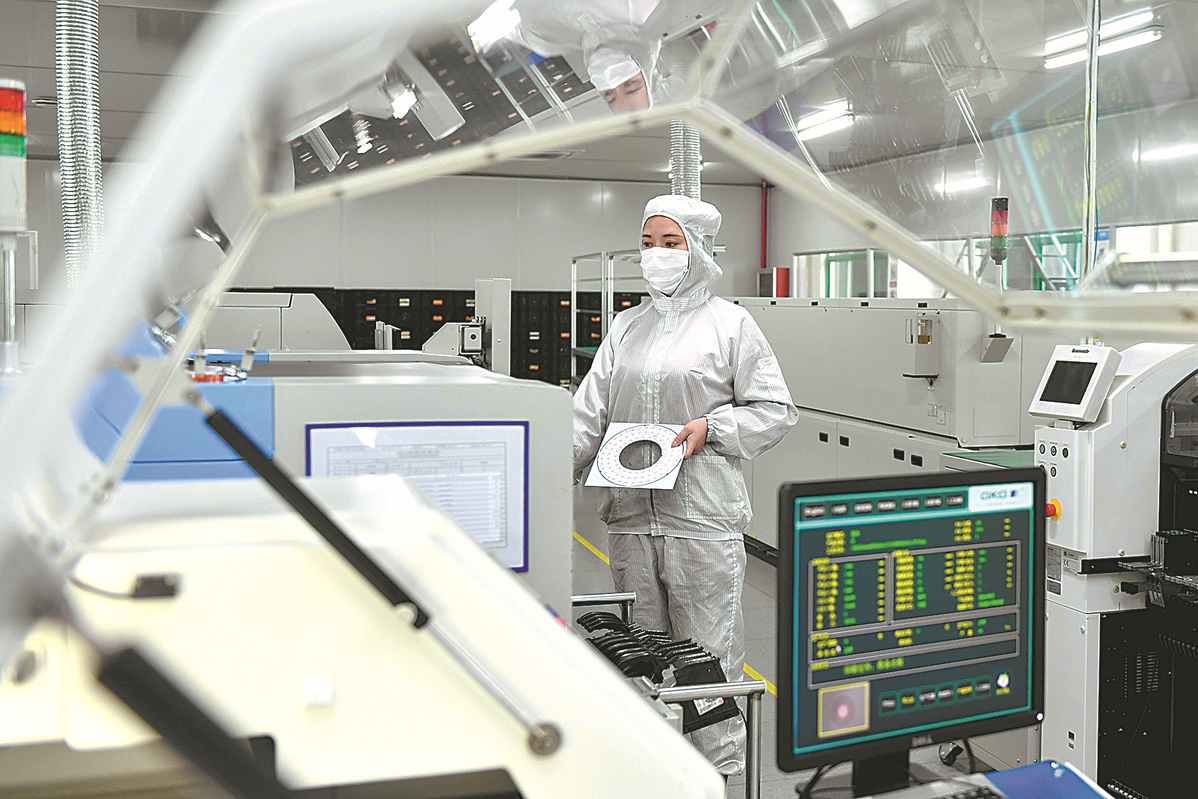
A worker operates an assembly line at a factory in Huzhou, Zhejiang, producing automated equipment. [Photo by Tan Yunfeng/For China Daily]
Easier access
Li, from Hanwei Electronics, said the company has enjoyed easier access to financing instruments and bank loans, and is also improving corporate governance to better adjust to new situations.
"We have attached great importance to online marketing and cross-border e-commerce, and believe such internet-based practices will continue to form an important trend in foreign trade, even after the pandemic," Li said.
Yin said Hubei Kingshan Lighting Electrico's overall transactions have risen by 20 percent to 30 percent thanks to increased income from online channels. Profits generated by related products have also grown by 20 percent.
He said the increased transactions for related products have helped the company negotiate with suppliers to reduce purchasing and transportation costs.
However, Yin and Li said rises in the renminbi exchange rate are a significant negative factor disrupting their companies' profits. They hope more external support will be provided so they can better cope with the situation.
Experts and business executives also stressed the positive role of the Regional Comprehensive Economic Partnership in shoring up China's foreign trade growth. The RCEP was signed by 15 Asia-Pacific economies, including the 10 member states of the Association of Southeast Asian Nations, China, Japan and New Zealand, in November 2020, and took effect on Jan 1.

Vehicles are assembled at Cowin Auto's plant in Yibin, Sichuan province, for export to a total of 10 countries and regions. [Photo by Zhuang Geer/For China Daily]
Zhang, from CAITEC, said the area covered by the partnership accounts for one-third of the global population, trade and GDP. This huge integrated regional market, with closer ties in production, value and supply chains, will see significant growth in goods and services trade and enhanced economic welfare, thanks to a reduction in trade and investment barriers.
The trade pact will become a strong force supporting China's foreign trade growth, as fellow RCEP members account for about one-third of the nation's foreign trade, he added.
Zhang also suggested that Chinese enterprises make better use of free trade agreements to enjoy tariff elimination and reduction.
Gao, from the China Chamber of Commerce for Import and Export of Machinery and Electronic Products, said implementation of the trade pact will accelerate the nation's shift toward capital and technology-intensive industries alongside global value chains, while machinery and electronic products will play an increasingly important role in foreign trade.
"China's trade in machinery and electronic products ranks high globally for volume and market share, thanks to high production capacity," Gao said. "Trade growth prospects for such technology-intensive and high-value-added products will remain positive."
Zhong Muda, deputy director-general of the Fujian provincial department of commerce, said the province has conducted more than 30 training sessions to increase enterprises' awareness and familiarity with the RCEP, and the training has attracted more than 70,000 participants online and offline.
Fujian aims to deepen cooperation between its enterprises and those in other RCEP countries through training sessions and other projects, he said.
To make full use of the agreement and reinforce industrial capability and supply chains, the province is also focusing on attracting foreign investment from leading enterprises in Japan and Singapore. This investment will advance development of sectors such as high-end equipment, new materials, new energy, semiconductors and devices, and biomedicine.
Photos
Related Stories
Copyright © 2022 People's Daily Online. All Rights Reserved.







